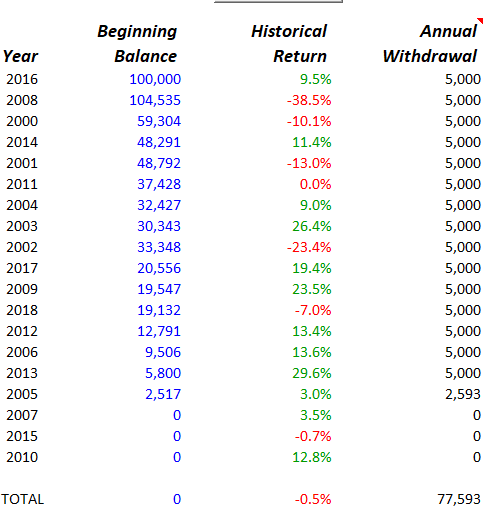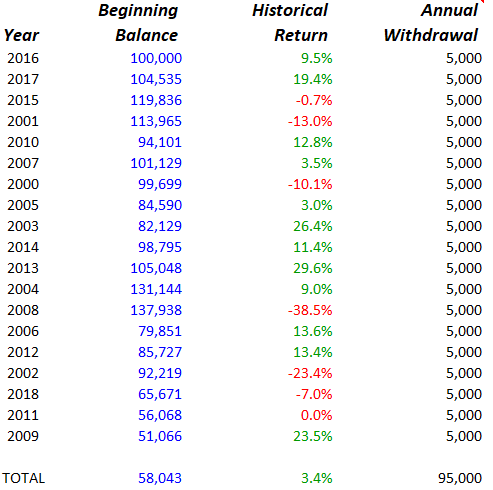One Retirement Risk You May Have Overlooked
No one wants to think their retirement security could depend on some stock market luck. But in a way, unless you've accounted for what's known as sequence of returns risk, bad luck could dash your dreams.


There’s a serious retirement risk out there that you might not have heard of, and it could have the power to determine the kind of retirement you will have. Have you thought about how sequence of returns affects your retirement?
The sequence of returns, or the order of the returns in your portfolio, does not matter until you start taking withdrawals out of an account. During your accumulation years while you’re working, you are not subject to this risk because you are not withdrawing money. But when you retire (during your distribution phase) you will be.
First, you must have a mind shift when going into retirement. You must go from an accumulation-only mindset to a distribution, preservation and an accumulation mindset. Just simply rolling your 401(k) into a portfolio and putting more of your assets in fixed income tools, like bonds, is not how you will eliminate sequence of returns risk.
From just $107.88 $24.99 for Kiplinger Personal Finance
Become a smarter, better informed investor. Subscribe from just $107.88 $24.99, plus get up to 4 Special Issues

Sign up for Kiplinger’s Free Newsletters
Profit and prosper with the best of expert advice on investing, taxes, retirement, personal finance and more - straight to your e-mail.
Profit and prosper with the best of expert advice - straight to your e-mail.
Sequence of returns risk is a result of the timing of withdrawals from a retirement account that can have a negative impact on the overall rate of return on the investment. This may seriously hurt a retiree who depends on the income stream from a lifetime of investing.
What is sequence of returns?
Sequence of returns is pretty much a matter of luck, meaning if you retire during a bull market and start taking withdrawals, your assets will most likely last longer than if you retired and started taking income from an account during a bear market. Considering that the current bull market is the longest in history, this concept could be more important than ever right about now.
Ever wonder why different people have different opinions of investing in the market during retirement? Look at the hypothetical examples showing having $100,000 in the market during a 10-year period and withdrawing 5% each year. You will see that the order of the returns of the market plays a big role in the final outcome. Keep in mind, both of these women experienced the same, real-world rates of return for their portfolios, just in a different order.
An Example: Two women with the same returns, but one goes broke
Initial Balance: $100,000
Withdrawal Rate: 5.00%
Betty Example No. 1

JoAnne Example No. 2

Note: This hypothetical example is for informational purposes only and is not indicative of past, nor intended to predict future performance of any Index or annuity product.
Is it fair to say that the sequence of returns JoAnne experienced may have provided a better result with the market than Betty ? If you look back, you will see they both started with $100,000 however, Betty ran out of money after 15 years, withdrawing a total of $77,593, while JoAnne has withdrawn $95,000 over the same amount of time and still has $58,043 left in her account.
What can you do to protect yourself from sequence of returns risk?
- Use the right tools for the right job. For income, do not put money into a vehicle like the stock market where the sequence of returns plays a big part. Instead, put it into an investment that will guarantee you a payout for life, like an annuity. By guaranteeing your living and lifestyle expenses are covered, you can put your other assets into investments that you won’t be pulling money from on a consistent basis, such as ETFs and bonds.
- Separate your assets into buckets that work for you differently. For example, secure liquid funds needed for large purchases in the beginning years of retirement in a stable vehicle in one bucket of assets, such as a bank account, money market account or CDs. In the next bucket, supplement your Social Security with other products that provide lifetime income, such as annuities. In a third bucket, determine your probable long term care costs and put money in a hybrid long term care product that does not have ongoing costs. That way you will have your long-term care needs covered down the road. All of your remaining assets should be put into an investment vehicle like ETFs, equities, bonds and mutual funds for future growth to keep up with inflation and taxes.
- Meet with a financial professional looking out for your best interest who is a fiduciary.
Did you know one of the biggest concerns for retirees is running out of money — even over death? Why risk your income in retirement based on the order of the returns of the market?
Protecting yourself against sequence of return risk means being prepared for the worst-case scenario. Don’t assume that you will have a bull market during all your retirement years.
Amy Buttell contributed to this article.
Licensed Insurance professional. Investing involves risk, including the loss of principal. No Investment strategy can guarantee a profit or protect against loss in a period of declining values. Any references to protection benefits or lifetime income generally refer to fixed insurance products, never securities or investment products. Insurance and annuity products are backed by the financial strength and claims-paying ability of the issuing insurance company.
Profit and prosper with the best of Kiplinger's advice on investing, taxes, retirement, personal finance and much more. Delivered daily. Enter your email in the box and click Sign Me Up.

Matthew Schuller is the president and founder of BrightPath Wealth Management. He takes his responsibility as a fiduciary seriously, because he knows how much good wealth management can mean for clients. He has eight years of experience working for a large financial products wholesaler, where he has helped advisers and insurance agents tailor products to their clients' portfolios.
-
 Why Playing It Safe in Retirement Is a Big Risk
Why Playing It Safe in Retirement Is a Big RiskFear of losing money could actually cost you in retirement. Find out why being too conservative with your life savings can hurt you and how to stop that from happening.
-
 Tax Refund Alert: House GOP Predicts 'Average' $1,000 Payouts in 2026
Tax Refund Alert: House GOP Predicts 'Average' $1,000 Payouts in 2026Tax Refunds Here's how the IRS tax refund outlook for 2026 is changing and what steps you can take now to prepare.
-
 What Not to Do in an Airport Lounge
What Not to Do in an Airport LoungeBefore you settle into that cushy lounge chair, skip the rookie moves that annoy other travelers and can even get you kicked out.
-
 I'm a Financial Pro Focused on Federal Benefits: These Are the 2 Questions I Answer a Lot
I'm a Financial Pro Focused on Federal Benefits: These Are the 2 Questions I Answer a LotMany federal employees ask about rolling a TSP into an IRA and parsing options for survivor benefits, both especially critical topics.
-
 5 RMD Mistakes That Could Cost You Big-Time: Even Seasoned Retirees Slip Up
5 RMD Mistakes That Could Cost You Big-Time: Even Seasoned Retirees Slip UpThe five biggest RMD mistakes retirees make show that tax-smart retirement planning should start well before you hit the age your first RMD is due.
-
 I'm a Wealth Adviser: My 4 Guiding Principles Could Help You Plan for Retirement Whether You Have $10,000 or $10 Million
I'm a Wealth Adviser: My 4 Guiding Principles Could Help You Plan for Retirement Whether You Have $10,000 or $10 MillionRegardless of your net worth, you deserve a detailed retirement plan backed by a solid understanding of your finances.
-
 A Retirement Triple Play: These 3 Tax Breaks Could Lower Your 2026 Bill
A Retirement Triple Play: These 3 Tax Breaks Could Lower Your 2026 BillGood news for older taxpayers: Standard deductions are higher, there's a temporary "bonus deduction" for older folks, and income thresholds have been raised.
-
 If You're Retired or Soon-to-Be Retired, You Won't Want to Miss Out on These 3 OBBB Tax Breaks
If You're Retired or Soon-to-Be Retired, You Won't Want to Miss Out on These 3 OBBB Tax BreaksThe OBBB offers some tax advantages that are particularly beneficial for retirees and near-retirees. But they're available for only a limited time.
-
 Waiting for Retirement to Give to Charity? Here Are 3 Reasons to Do It Now, From a Financial Planner
Waiting for Retirement to Give to Charity? Here Are 3 Reasons to Do It Now, From a Financial PlannerYou could wait until retirement, but making charitable giving part of your financial plan now could be far more beneficial for you and the causes you support.
-
 Time Is Running Out to Make the Best Moves to Save on Your 2025 Taxes
Time Is Running Out to Make the Best Moves to Save on Your 2025 TaxesDon't wait until January — investors, including those with a high net worth, can snag big tax savings for 2025 (and 2026) with these strategies.
-
 4 Smart Ways Retirees Can Give More to Charity, From a Financial Adviser
4 Smart Ways Retirees Can Give More to Charity, From a Financial AdviserFor retirees, tax efficiency and charitable giving should go hand in hand. After all, why not maximize your gifts and minimize the amount that goes to the IRS?